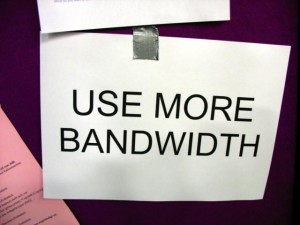Does your mobile phone provide better quality than a typical webcam? I'll test some virtual webcam software for mobile.
Bandwidth pricing: Enabling the future
 Anyone over 40 was witness to the drastic reduction in per minute long distance calling rates, they fell like a rock and today long distance telephony costs are no longer a cost concern for most corporations. Along the way, numerous LD companies got killed, but the survivors got horribly efficient, drastically cutting costs in people and capital expenditures. We, the consumer, won and now none of us think much about making an national or even international call. Low long distance rates spurred increased communications, likely increasing the overall efficiency of a business.
Anyone over 40 was witness to the drastic reduction in per minute long distance calling rates, they fell like a rock and today long distance telephony costs are no longer a cost concern for most corporations. Along the way, numerous LD companies got killed, but the survivors got horribly efficient, drastically cutting costs in people and capital expenditures. We, the consumer, won and now none of us think much about making an national or even international call. Low long distance rates spurred increased communications, likely increasing the overall efficiency of a business.
A broadband company recently asked for my take on broadband pricing trends. The picture starts to look a lot like long distance telephony and the same economic pressures and actions will occur. Just a few short years ago, companies were paying in excess of $500 a month per Mbps for Internet access. Today, you can easily purchase a single T-1 of Internet access (1.5 Mbps) for $250 a month or $166 per Mbps. A dramatic reduction, but is more coming?
In most major metro areas, you can find higher speed Internet access at rates around $100 per Mbps. So if you need a 10 Mbps effectively Ethernet rate Internet connections that ‘s a easy $1,000 a month. These services are delivered via broadband wireless, inbuilding fiber optic cable or Copper over Ethernet (bonding leased copper pairs of wire to achieve higher speeds). These Internet Service Providers don’t own cables into your building and instead continue to lease them from the local telco. A leased copper pair is ~ $20 a month and can support speeds of above 2 Mbps. Thus in this example, you’d need 5 pairs to support 10 Mbps. Thus your ISP has underlying costs of $100 with revenue of $1000. A nice business.
But your ISP doesn’t ‘own’ any of the actual facilities and thus the opportunity for price to decline further. Verizon FIOS now offers business services and for a mere $189 a month, you get 50 Mbps connection (20 Mbps). Even if you only count the 20 Mbps up, that works out to be < $10 per Mbps. ISP’s will be quick to say that FIOS isn’t the same as ‘their’ Internet. But at 90% less money, who cares.
The future is all about more for less and clearly a number of non-facilities ISPs will simply be unable to play at this poker table of low priced Mbps. At a competitive disadvantage, they will either sell out or simply vanish. While clearly some losers, the winners will be American businesses who will suddenly find that 100 Mbps Internet connectivity is an easy economic decision.
What will people do with this new found bandwidth? Who knows for sure, but history has shown that when inexpensive resources are available, applications appear to take advantage of it. Clearly, low cost bandwidth will be a boon to SaaS type applications, back-up, off site storage, running your applications in some far off data center. In fact, it’s not hard fetched to imagine a company doing away with it’s inbuilding data center and simply outsourcing all the necessary hardware components.